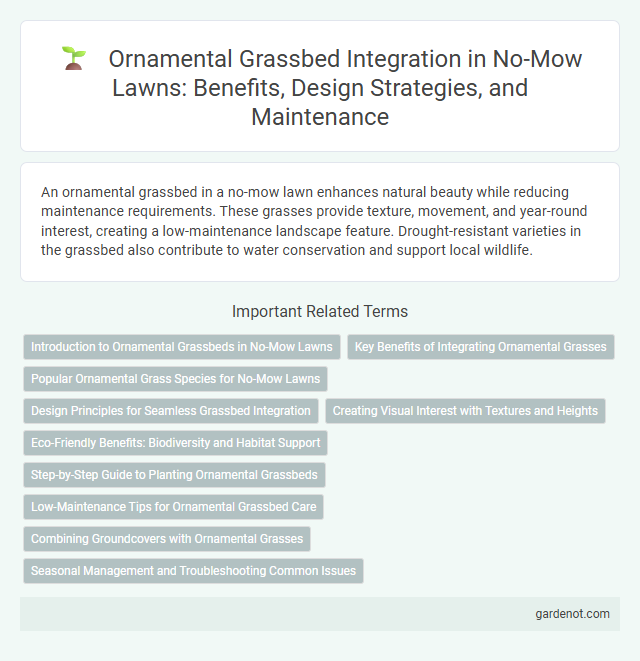An ornamental grassbed in a no-mow lawn enhances natural beauty while reducing maintenance requirements. These grasses provide texture, movement, and year-round interest, creating a low-maintenance landscape feature. Drought-resistant varieties in the grassbed also contribute to water conservation and support local wildlife.
Introduction to Ornamental Grassbeds in No-Mow Lawns
Ornamental grassbeds offer a low-maintenance, eco-friendly alternative within no-mow lawns, enhancing landscape aesthetics with minimal upkeep. These grassbeds use species like fountain grass and blue oat grass, which thrive without frequent mowing and provide texture, movement, and year-round interest. Integrating ornamental grassbeds reduces water consumption, supports biodiversity, and creates sustainable, visually appealing outdoor spaces.
Key Benefits of Integrating Ornamental Grasses
Integrating ornamental grasses into no-mow lawns enhances biodiversity by providing habitats for pollinators and beneficial insects. These grasses improve soil health through deep root systems that reduce erosion and increase water retention. Their low-maintenance nature and drought tolerance contribute to sustainable landscaping with reduced water usage and mowing requirements.
Popular Ornamental Grass Species for No-Mow Lawns
Popular ornamental grass species for no-mow lawns include Blue Fescue (Festuca glauca), known for its fine-textured blue-green foliage and low maintenance needs. Switchgrass (Panicum virgatum) offers height and seasonal color changes, thriving in diverse soil types while requiring minimal mowing. Carex species, especially Carex oshimensis, provide a lush, dense ground cover with excellent drought tolerance, making them ideal for sustainable and visually appealing no-mow landscapes.
Design Principles for Seamless Grassbed Integration
Ornamental grassbeds enhance no-mow lawn aesthetics by incorporating diverse grass species that vary in texture, height, and color to create depth and visual interest. Strategic placement following principles of balance, rhythm, and harmony ensures seamless integration with existing landscape elements, promoting a natural flow and cohesive design. Utilizing layered planting techniques and complementary groundcovers stabilizes soil and reduces maintenance, optimizing the overall health and appeal of the grassbed.
Creating Visual Interest with Textures and Heights
Ornamental grassbeds enhance no-mow lawns by introducing varied textures and heights that create visual interest and depth. Planting a mix of tall pampas grass, medium-height fountain grass, and low-growing blue fescue adds dynamic layers that attract pollinators and provide movement in the landscape. These grasses require minimal maintenance while promoting biodiversity and contributing to a sustainable, aesthetically pleasing outdoor space.
Eco-Friendly Benefits: Biodiversity and Habitat Support
Ornamental grassbeds in no-mow lawns enhance biodiversity by providing essential habitats for pollinators, birds, and beneficial insects. These low-maintenance grassbeds improve soil health through natural aeration and organic matter accumulation, reducing the need for chemical fertilizers. By supporting native ecosystems, ornamental grassbeds contribute to sustainable landscaping and promote ecological balance.
Step-by-Step Guide to Planting Ornamental Grassbeds
Choose drought-tolerant ornamental grasses like fountain grass or blue fescue for a no-mow lawn to reduce maintenance and enhance curb appeal. Prepare the soil by loosening it and incorporating organic compost to promote healthy root growth before planting. Space the grasses 12-18 inches apart to allow for mature growth, then mulch around the plants to retain moisture and suppress weeds effectively.
Low-Maintenance Tips for Ornamental Grassbed Care
Ornamental grassbeds thrive with minimal upkeep by focusing on proper soil preparation and mulching to retain moisture and suppress weeds. Select drought-tolerant grass varieties like Miscanthus or Fountain Grass for reduced watering needs and cut back dead foliage annually to promote healthy growth. Regular but infrequent watering combined with seasonal trimming ensures a vibrant, low-maintenance ornamental grassbed year-round.
Combining Groundcovers with Ornamental Grasses
Combining groundcovers with ornamental grasses creates a low-maintenance no-mow lawn that enhances texture and visual interest while preventing soil erosion. Groundcovers such as creeping thyme or sedum complement ornamental grasses like blue fescue or fountain grass by filling gaps and suppressing weeds, maintaining a lush, weed-free lawn space. This combination improves biodiversity and supports pollinators, making it an eco-friendly landscaping choice for sustainable gardens.
Seasonal Management and Troubleshooting Common Issues
Ornamental grassbeds in no-mow lawns require seasonal management such as leaving foliage intact during winter to protect roots and cutting back dead growth in early spring to encourage healthy regeneration. Address common issues like pest infestations and fungal diseases by ensuring proper air circulation and avoiding excessive moisture. Regular monitoring promotes a vibrant, low-maintenance landscape with minimal intervention.
Ornamental grassbed Infographic

 gardenot.com
gardenot.com